THE DETERMINATION OF SISTERS OF NOTRE DAME AROUND THE WORLD
This is my first letter to appear in Cross Currents, which has long chronicled the work of the Sisters of Notre Dame de Namur. In its pages are and have been the accomplishments of the Sisters, but also the challenges, challenges we have faced — and continue to face — together. In any given issue, you’re likely to read about Sisters in inner-city neighborhoods, in the deserts of the American Southwest, or in jungle locales thousands of miles away.
Cross Currents has helped me see the mission of Notre Dame from all its many angles. It’s helped me learn new things, and helped me experience our faith as seen through the eyes — and through the work — of the Sisters. Now, with the opportunity presented by this column, I have a chance to be a part of the process. And I’m grateful.
In the current issue you’ll read about the canonization of Julie Billiart fifty years ago this summer, and how that canonization may never have happened were it not for the steady determination of Sisters of Notre Dame around the world — the same kind of determination that built schools where before there had been none, that today sinks wells to the far ends of the earth, and that no matter the circumstance, finds God in all things.
It’s the same kind of determination, too, that leads young women to devote their lives to something larger than themselves (see page 8), and who, by doing so, are continuing the tradition begun so long ago by Saint Julie Billiart.

Sincerely,
KEVIN MANLEY Director of Development
ACT ONE:
This is a story not before told in one place. Its parts have for decades resided in obscurity: in three paragraphs of the 1952 internal communications of a religious congregation; in sworn affidavits of people long since deceased; in the archived tomes of the Holy See.
Some accounts match, some differ. Some are in Portuguese, some English. Some are reported in the weeks following, some from a vantage point of thirty years hence.
But at its root the story is this...
SISTERS OF NOTRE DAME DE NAMUR
WERE IT NOT FOR A FARMER CONTINUED ON PAGE 4 CROSS CURRENTS
On a mild night in the village of Mata Virgem, twenty-seven miles from the Brazilian town of Campos Novos, a father — a farmer and most likely a beekeeper — is struggling to help his son into a truck. The son — Otacilio Ribeiro da Silva, 29 years old, married, also a farmer — is shaking with pain. The date: September 29, 1950.
The two drive to the town’s hospital. Sister Maria Bardona, a Coesfeld Sister of Notre Dame, meets them at the door. Of the son, she said later, “He looked as if he would be gone if he closed his eyes.”
The hospital’s superior arrives, Sister Mary Ludvine. Upon seeing the son she calls both a priest and a doctor. The doctor’s name is Janh Martins Ribeiro (no relation to the family). Dr. Ribeiro orders immediate surgery. Otacilio’s body is so contorted with pain he is unable to lie down. An anesthetic is administered. As it takes hold, Dr. Ribeiro says to the Sisters, “Call his father for it is quite certain he will not see him again alive.”
The operation begins. A terrible tumor comes into view. In the words of Sister Mary Ludvine: “It was hard as a stone and of a dark red color, and filled the entire abdomen…The doctor tried to loosen the tumor to remove it, but from no side could it be moved. Almost without knowing what to do, he tried over and over to make the tumor yield, and worked
at it for a long time. But it was impossible.”
“He is condemned,” said the doctor. “There is no hope.”
The Sisters move Otacilio, still unconscious, to another room. Sister Ludvine asks what further medical measures should be undertaken. “Sister, Sister,” the doctor says, “…he will not live another hour.”
Sister Ludvine, Sister Bardona, and a third Sister, Sister Maria Adelaide, begin to pray. Otacilio’s father sits by the bedside. The night moves on.

whereupon the family, with no other recourse, begins to pray. They begin a fervent novena and place upon Monsieur Rhodius a relic of the then Blessed Julie Billiart, presumably supplied by Sister Marie-Ludovica, his daughter and a Sister of the Namur branch of the Sisters of Notre Dame. After two days, Monsieur Rhodius wakes up. On the fourth day, he is able to take nourishment. Within a month he returns to work. No sign of his malady ever returns.
Perhaps the Coesfeld Sisters of Notre Dame – a generation and an ocean removed, speaking a different language, praying through the night in Campos Novos – recall this miracle. But if they do, no mention is later made of it in the congregation’s December 1952 Chimes newsletter, when Julie Billiart is still Blessed Julie, and when Sister Ludvine first writes, in a brief three paragraphs, of the incident of Otacilio Ribeiro preceded by the comings and goings of the day, such as the number of calves and chickens prepared for the Feast of St. John the Baptist.
Sister Ludvine explains what has transpired. She speaks of Blessed Julie and of their petitions. She attaches a picture of the foundress to the wall and places a relic over Otacilio’s incision. She invites Otacilio to join them in a novena, which he does.

Still, even after three days of further life, the doctor says again there is no hope. But then something happens. On either the third evening or the fourth (Sister Ludvine, years later, could not remember), Otacilio calls out, “Sister, there is something so very unusual. I cannot explain it but it is quite different.”
“Otacilio,” says Sister Ludvine, making the sign of the cross on his forehead, “the dear God is good. He will be with you this night. Pray to your saint.” Then she leaves, leaving him alone. The night passes. At five o’clock Sister Ludvine returns. She finds Otacilio sitting up in bed, smiling.
CROSS
Stop now. Go back an even further thirty-one years and into another hemisphere. It’s November 20, 1919 in Namur, Belgium. Monsieur Homer Rhodius, long ill with renal disease, lies on his deathbed. He receives the Last Sacraments and falls into a deep coma. His attending physicians give him less than a day, and exit,
More likely is that the wee hours of September 30, 1950 are a crush of panic, disbelief and sadness displacing all else, the father now joined by the mother at their son’s bedside, the Sisters praying, the 29-year-old Otacilio supine and unresponsive. Finally, almost unexpectedly, first dawn shows through the window. Death has not appeared. The sun rises. Otacilio comes to.
“I could get up,” he says. Sister Ludvine, recovering from her shock, won’t allow it. They wait for the doctor. At nine the doctor comes in.
“What have you done to him?” he says. He examines the incision and abdomen. He says repeatedly, as much to himself as to others, “What has become of the growth? Where did the growth go? ”
A week later Otacilio is released. His parents give the Sisters one
and a half kilograms of wax for candles. Otacilio promises, “If the good Lord would give me one more daughter, she shall be called Julie.”

Two months later he returns, now on horseback. He swings out of the saddle, calling, “Sister, do you remember me yet?”
With that, and with the 1952 mention in the Chimes newsletter, the story might end. But it doesn’t.
ACT TWO:
In 1952, Mother Mary Verona, an assistant mother general of the Coesfeld Sisters of Notre Dame, residing in Rome and in a free moment, thumbs through the December issue of her congregation’s newsletter.
Mother Verona, knowing very well of the 1919 miracle of Monsieur Homer Rhodius, much involved in the decades-long effort to canonize Blessed Julie, well connected with the Church hierarchy, reads casually of the work of a Sister Bardona and a Sister Ludvine in the faraway town of Campos Novos. She reads of the fatted calves slaughtered for the Feast of St. John the Baptist, and of the number of chickens prepared.
And Mother Verona reads those three paragraphs of the illness and recovery two years earlier of the farmer from the village of Mata Virgem. At which point she stops.
5 4
CURRENTS
Sister, there is something so very unusual. I cannot explain it but it is quite different.”
— OTACILIO
SISTERS OF NOTRE DAME DE NAMUR
CONTINUED ON PAGE 6
Call his father for it is quite certain he will not see him again alive.”
— DR. RIBEIRO
In the three branches of Notre Dame tracing back to Julie Billiart— the Sisters from Namur in Belgium, the Coesfeld Sisters from Germany and the Dutch Sisters in Amersfoort — perhaps only a handful know the starts and stops, ups and downs, and the seemingly miraculous intercessions of Julie over the years, intercessions that for all their merit could not be proved to the standards of the Vatican and so count as the second miracle required for canonization.
But in this handful of Sisters is Mother Verona. And before her is a newsletter she has found time to read. And in this one particular newsletter is news from the far
reaches of the congregation written two years after the fact.
Mother Verona immediately takes the newsletter to the Secretary of the Sacred Congregation of Rites, whom she knows. The Congregation of Rites is the then Secretariat within the Church tasked with the causes of saints.
“They have written such a little bit about it,” she says to the Secretary, and which she recounts later.
“Without date, without names, without anything.”
To which the Secretary, after reading the three paragraphs, says, “Ask the Sisters in Brazil to write a more complete report, and then we will see.”
The word goes out to Sister Ludvine in Brazil, who complies. Participants are interviewed, proceedings held, affidavits sworn. Documents flow back and forth between Rome and the Diocese of Lages, in which the purported second miracle is said to have occurred. The wheel of canonization, stalled after the 1919 miracle, begins again to creak forward.

It takes another four years, into 1958, for the miracle in Brazil to be authenticated. In 1959, Mère Josepha de St. François, Mother General of the Sisters of Notre Dame de Namur, requests an audience with Pope John XXIII, hoping to move forward with the process of canonization. But

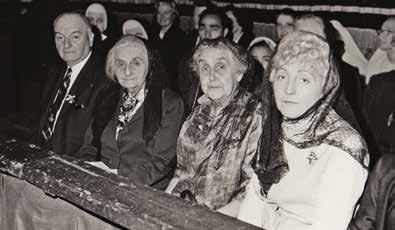
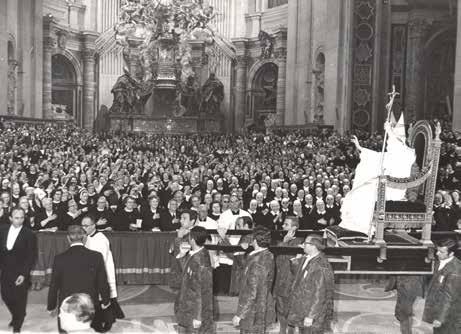
the pope says to her: “Our good religious are all begging for the canonization of their foundresses. Let them sanctify themselves. That will give greater glory to God.”
Mère Josepha, in her own words, is “struck with consternation.”
Nevertheless, and swallowing her disappointment, she drafts a note to the pope thanking him for his time. A few days later a return note arrives, coming through the pope’s secretary. “ the Sacred Congregation of Rites will be acquainted with your desire,” it says.

The wheel creaks slightly, then, in 1967, is quieted again. The miracle of Monsieur Homer Rhodius, dating
back to 1919, is to be examined once more. There is the possibility of reversal. Sisters of Notre Dame on five continents await the outcome.
ACT THREE:
More years pass. The pope is now Paul VI. It’s June 22, 1969, sunny and hot. In twenty-nine days men will land on the moon. (When the canonization process began, men had yet to fly.)
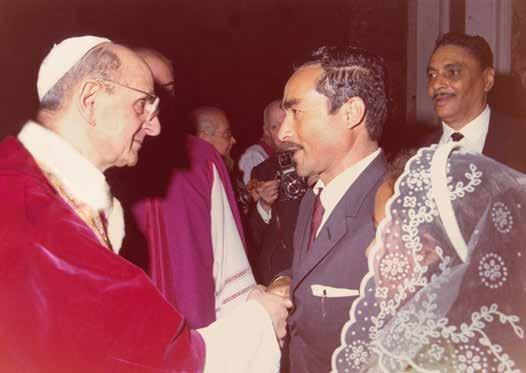
Mother Mary Verona is in St. Peter’s Basilica. With her are eight hundred Coesfeld Sisters of Notre Dame, Sisters of Notre Dame of Amersfoort, and Sisters of Notre Dame de Namur, including Mère
Josepha. There, too, are relatives of Julie Billiart, bearing a striking resemblance. Media from the four corners of the world wield cameras and notepads. There are prelates in clerical garb, and men in coats and ties. Among the latter is the doctor Janh Martins Ribeiro.
Pope Paul VI enters. He formally declares Marie Rose Julie Billiart, of Cuvilly, France as the Church’s newest saint — Saint Julie. He offers Communion. Among those receiving it is a dark, mustachioed farmer from the village of Mata Virgem, twenty-seven miles from Campos Novos. Beside him is a girl of fourteen. Her name, too, is Julie.
7 6 SISTERS OF NOTRE DAME DE NAMUR CROSS CURRENTS
RIGHT: Sister of Notre Dame de Namur Mère Josepha de St. François
BELOW:
Coesfeld Sister of Notre Dame Mother Mary Verona
RIGHT: Pope Paul VI and Otacilio Ribeiro
LEFT: Pope Paul VI greets Sisters of Notre Dame.
RIGHT: St. Julie Billiart’s relatives attend her canonization at the Vatican.
WE WILL ALWAYS REMEMBER
SISTER THERESE M c MENAMIN
Formerly Therese Aloysius
December 28, 1923 – February 3, 2019
Sister Therese served as teacher and principal nearly three decades, giving her students the kind of solid formation in faith and love that her parents had given her. As a licensed speech therapist, she saw her work as easing an impediment that could otherwise block a gifted child’s realization of his/her full potential. She came to regard her students as the “prime movers” in her life — “the power behind who I have become!”
SISTER CLAIRE FOLEY
Formerly Mary Harold • Aug ust 14, 1938 – February 3, 2019
SISTER PATRICIA KINSER
Formerly Helen Patricia August 12, 1925 – December 9, 2018
As a teacher and principal, Sister Patricia provided a quality Catholic education to students who most needed it. Like St. Julie, she taught her students what they needed to know for life and changed lives one person at a time. Her many volunteer experiences helped her carry out her lifelong preference to care for the materially poor. Sister Patricia loved nature — it was where she found God’s presence most real.
A NEW SISTER!
Sister Sarah Cieplinski made final vows as a Sister of Notre Dame de Namur on December 29, 2018 at Mount Notre Dame in Cincinnati. It’s a journey she’s been on since high school, she says. Her love of God, her love of St. Julie and her love of teaching have come together in a ministry in South Central Los Angeles, where she teaches children with disabilities. “God kept nudging me,” she says, “and St. Julie inspired me.”
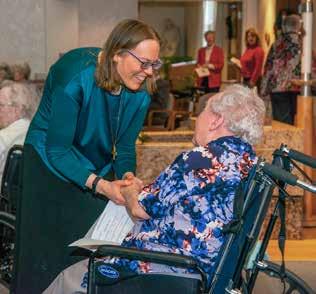

A NEW NOVITIATE!
The United States provinces of the Sisters of Notre Dame de Namur, including the Ohio Province, have opened a novitiate in Cincinnati. The novitiate, opened since August in the former rectory of Our Lady of Lourdes Parish, houses seven Sisters and one canonical novice, Gillian Wallace, who is originally from California. Other Sisters in residence have come from as far away as California, Arizona, Vermont and Massachusetts.
ABOVE
Members of the novitiate community enjoy an evening meal together. They include (clockwise from lower left) Sisters Stephanie Thompson, Gillian Wallace, Thérèse DelGenio, Dolores Moloney, Judith Flahaven, Bernadette LeTourneau and Marietta Fritz (not pictured, Sister Karen Pozniak).
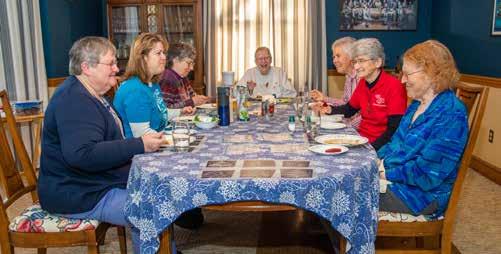
Sister Claire loved teaching, showing her students interest, warmth and support. As principal and assistant superintendent, she worked to improve ways the curriculum met the needs of students. Sister Claire responded to the call to serve in leadership for her community with competence, contagious energy and commitment to mission. She served on the province leadership team three times including one term as Provincial. She served as wisdom figure, mentor and advisor for Sisters, family and friends.
SISTER JANET HUGHES
Formerly Ann Raymond • January 16, 1931 – January 17, 2019
Sister Janet lived St. Julie’s example of a contemplative life in an active ministry. Every location where Janet ministered benefited from her attention to detail, her organizational skills, her quiet presence and her genuine interest in and care for those around her. She felt every person she met enriched her life and prayed that somehow her presence enriched them in return.
SISTER PHYLLIS DUGAN


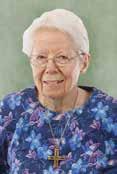

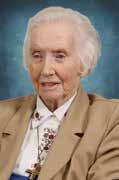
Formerly Mary Regina November 3, 1927 – October 22, 2018
Her students saw Sister Phyllis as an excellent teacher and as someone who would listen and respond compassionately. In her parish work, she used her gifts for listening and compassion to help plan the future life of the local church. In all her ministries, she nurtured a spirit of cooperation, creativity and community. Throughout her life, Sister Phyllis found a “real joy in serving people.”
9 8
CROSS CURRENTS SISTERS OF NOTRE DAME DE NAMUR
Fischer during the Sign of Peace.
LEFT Sarah recites her vows in the presence of the Provincial Leader, Sister Carol Lichtenberg.
CONTINUED ON NEXT PAGE
WE WILL ALWAYS REMEMBER
EDUCATION IS THE GREATEST WORK ON EARTH.
SISTER JANE ROBERTS

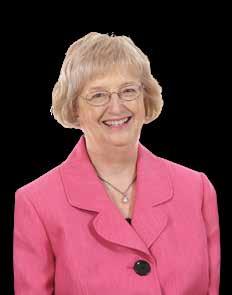
Formerly formerly Robert Marie • June 11, 1927 – September 29, 2018
Sister Jane was known for her calm, quiet, determined presence. As a formal educator, Sister Jane’s students taught her about the gifts and challenges of diversity and community. As a director of religious education, she loved watching a generation of parishioners grow into faith-filled young adults. In her final work as a paralegal, Sister Jane most enjoyed the pro bono work for individuals and families in great need, concretely living the words of St. Julie.
SISTER ANNE ELIZABETH BERINGER
September 11, 1926 – September 5, 2018
Sister Anne saw her life as “working with God” — a lifetime characterized by openness to all that was new and different. She worked with non-traditional students and loved teaching, especially at the high school and college levels. She was a talented artist who brought beauty to our world. She was a citizen of the world and carried her family and Sisters in her heart all her life long.
SISTER MARIAN HOLAHAN
Formerly Agnes Joseph • June 14, 1928 – August 27, 2018


Sister Marian’s infectious laugh, gift of song and wide-ranging ministries are among her most memorable gifts. “Adaptable” was her middle name — she taught elementary, middle and secondary students before transitioning to assist the elderly. Then she was back to teaching and administration at the high school level. Sister Marian had tenacious faith in God’s goodness throughout her full and varied life.
SISTER MAUREEN TURLISH
Formerly Maureen Paul
July 5, 1939 - July 18, 2018
Sister Maureen was known as a tenacious, outspoken activist. She taught for three decades, and art was her specialty. She made children’s access to art instruction one of her causes, arguing for its essential role in the quality education of children. Called as a Sister to care for the sexually exploited, trafficked, marginalized and abused, Sister Maureen demanded protection of children from clergy abuse and compensation for adults bearing its scars.
WE ARE MINDFUL THAT WE STAND ON THE SHOULDERS OF THOSE WHO HAVE COME BEFORE US
TO READ A MORE DETAILED OBITUARY OR TO LEAVE A COMMENT, VISIT 'ABOUT US' ONLINE AT: SNDOHIO.ORG
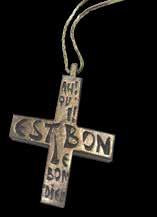



St. Julie Billiart, foundress of the Sisters of Notre Dame de Namur, once said “Education is the greatest work on earth.” This is also the perfect motto for the late Dr. June Verbillion who taught for more than three decades—a fitting career for this 1953 alumna of Notre Dame High School in Chicago.
June and her sister were raised in a strong Catholic family. Her early love of reading led to four successful years at Notre Dame High School, a school known for its academically rigorous curriculum and diverse student body.
Thanks to the extensive academic opportunities provided by the Sisters, June went on to earn her undergraduate degree at DePaul and her doctorate at Loyola University Chicago, becoming the first Notre Dame High School alumna to receive an EdD. June then joined the faculty of Northeastern Illinois University, serving as a professor of English Literature for 31 years.
June touched the lives of so many students over the years, and she never forgot those who taught her and set her on her life’s mission of teaching. To show her appreciation, June decided to make a gift to the Sisters of Notre Dame de Namur through her IRA and retirement plans.

Naming the Sisters as a beneficiary of an IRA or other retirement plan is a simple way to leave a legacy. IRAs or other retirement plans can be designated as gifts to one or more charitable organizations. This can make especially good tax planning sense since these funds are more heavily taxed if left to heirs.
We are grateful to Dr. June Verbillion for her years as a professor, and we are honored she remembered her Catholic education with a gift to the Sisters through her retirement plans. If you would like to learn more about IRA and retirement plan giving, please contact me today at khadden@ohsnd.org or 513-679-8106.
KAREN HADDEN Associate Director of Development
11 10 SISTERS OF NOTRE DAME DE NAMUR CROSS CURRENTS
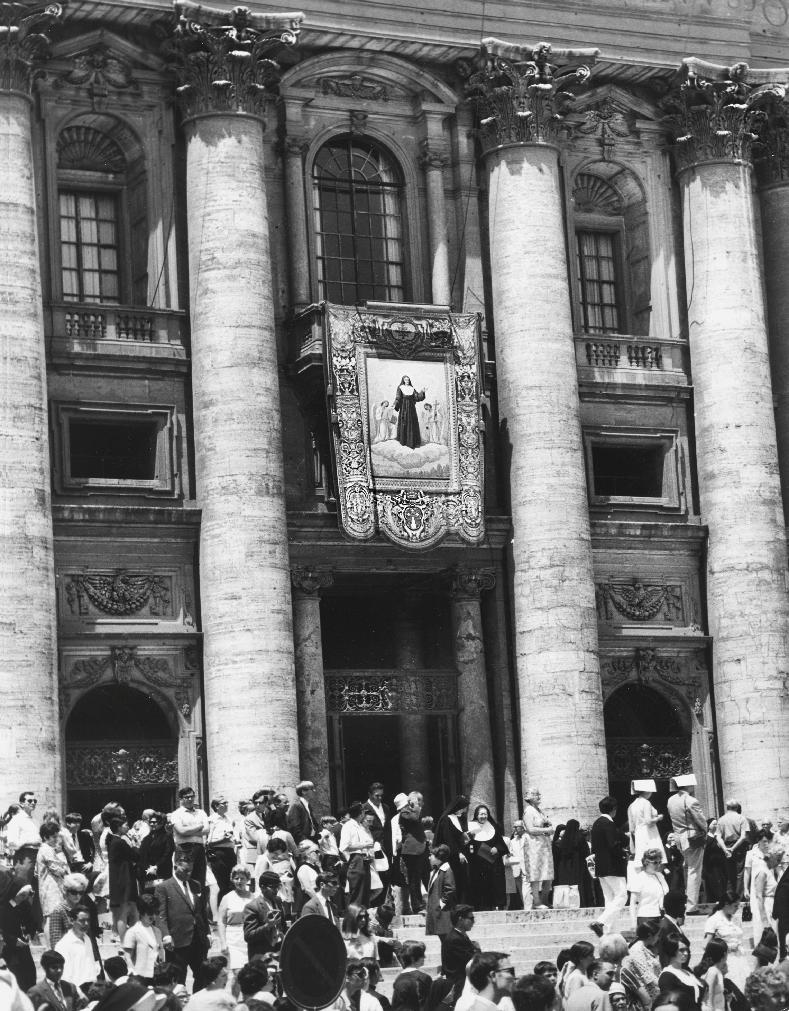 The Canonization of Marie Rose Julie Billiart • June 22, 1969
The Canonization of Marie Rose Julie Billiart • June 22, 1969































